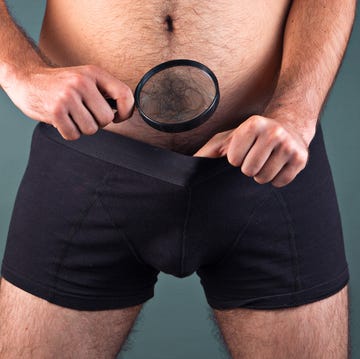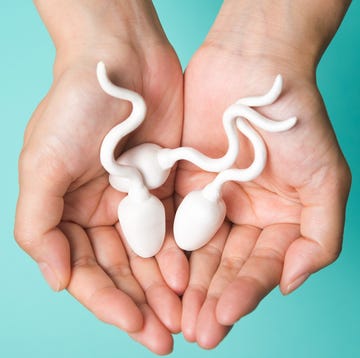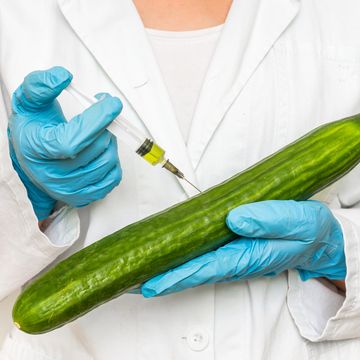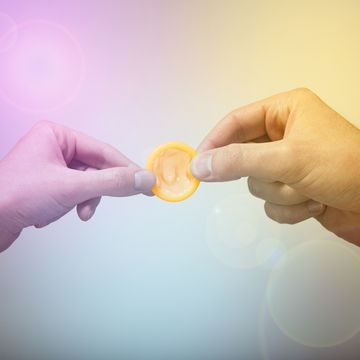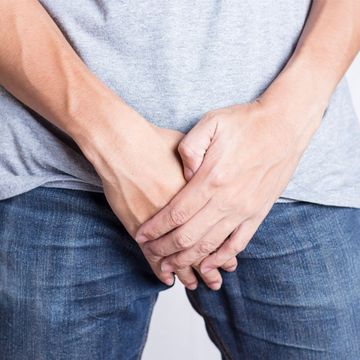Looking down at your junk, you can’t help but notice…bumps. Maybe quite a lot of them, at the bottom of the head of your penis. Sometimes there can even be more than one row of them, too.
Bumps on your penis are never a good thing—right?
Well, they can signal certain sexually transmitted infections, but the kind of tiny bumps we’re talking here are quite different. They’re called pearly penile papules, and they appear as one or two rows of tiny, dome-shaped bumps.
But what are these pearly bumps on your penis? And how can you tell they are nothing to worry about? Read on to put your penis worries at rest (Here are 15 other facts you never knew about your penis).
What are pearly penile papules, really?
The fancy name is hirsuties coronae glandis. They’re lesions that are pearly white and are a normal variant of penis anatomy, according to S. Adam Ramin, M.D., urologist and medical director of Urology Cancer Specialists in Los Angeles.
They’re not a disease, abnormality, or cancer risk. They’re just little bumps—usually a lot of them—between your penis head and shaft (You can find out what they look like here, and no, it’s NSFW).
And they’re more common that you may think: About 38 percent of guys under age 25 have them, compared to 11 percent of those over age 50, a 2009 study from the U.K. found. That shows that they tend to regress, or at least become less noticeable as you get older (Here are 5 other things that happen to your penis as you get older).
Pearly penile papules are more likely to appear in uncircumcised guys, but can sometimes happen if you’re circumcised. In the same study, 27 percent of circumcised patients had the bumps, compared to 42 percent of uncircumcised guys.
6 Things Every Man Should Know About His Penis:
How do you tell if pearly penile papules are harmless?
Many guys mistake them for genital warts, but those are small, cauliflower-shaped growths that sometimes look scaly and, well, warty. Pearly penile papules, on the other hand, are much smaller—often only about 1 millimeter (mm) wide—and won’t have that “dried out” look of genital warts.
They also don’t grow larger, confine themselves to one spot—instead they usually wrap around the penis—or cause any pain. If you’re experiencing any of those symptoms, or the condition is new, it’s time to see the doctor.
Another thing to keep in mind is that not only are they harmless to you, but also to others. Since it’s not an infection or STD, there’s no risk of transmitting your bumps when you bump (But here are 4 STDs you might already have and not know it).
Have you had them for a while, especially from your late teens or early 20s onward? Then they’re probably harmless, according to Philip Werthman, M.D., urologist and director of the Center for Male Reproductive Medicine and Vasectomy Reversal in Los Angeles.
“If it truly is papules, then you’ve likely had them for a long time,” he says. “They don’t just pop up one day later in adulthood.”
Should you remove pearly penile papules?
According to a study published in the International Journal of STD & AIDS, over one-third of men with pearly penile papules had been concerned or worried about their lesions, and about 1 in 4 said they were embarrassed of them. So it’s not really surprising that 14 percent of men with small lesions (less than 1 mm) and 75 percent with larger ones (greater than 1 mm) wanted to have them removed.
So yes, it’s possible you can remove them, with techniques like laser treatments or radiofrequency ablation.
But there’s no reason to zap them, Dr. Werthman says. They very rarely cause any sort of complications or problems, and it’s usually just a cosmetic issue if you want them gone. (Here's the scientific way to tell if your penis is attractive).
The better approach? Simply make peace with your pearly penile papules.
“They’re perfectly normal, and nothing to worry about,” he says.








